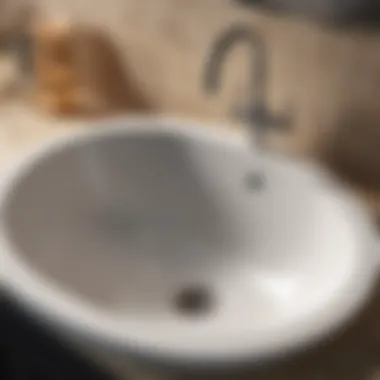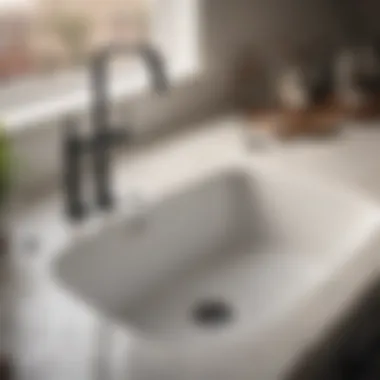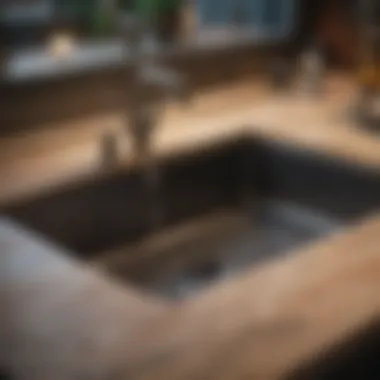Effective Techniques for Easily Unclogging a Sink


Inspiring Homes
When it comes to managing household issues, tackling a clogged sink swiftly and effectively can significantly impact daily routines. Understanding practical methods to address this common problem is essential for maintaining a smoothly functioning home environment. Whether you opt for DIY solutions or seek professional assistance, knowing the most effective approaches can save time, money, and potential frustration.
Understanding Sink Blockages
Sink blockages are a common household nuisance that can disrupt daily activities. From kitchen sinks filled with food scraps to bathroom sinks clogged with hair, understanding the root causes of these blockages is crucial to maintaining a smoothly functioning drainage system. In this article, we will delve into the various factors that contribute to sink clogs and explore effective methods to tackle them effortlessly. By comprehending the common causes of sink blockages, individuals can proactively prevent these issues and ensure a hassle-free sink usage experience.
Common Causes of Sink Clogs
Food Residue Accumulation
Food residue accumulation is a prevalent issue in kitchen sinks, often caused by disregarding proper disposal practices. The remnants of food particles and grease can gradually build up in the pipes, leading to stubborn clogs. This accumulation not only hampers water flow but also creates a breeding ground for bacteria and foul odors. Addressing food residue accumulation promptly is essential to prevent severe blockages and maintain a hygienic sink environment.
Hair Buildup
Hair buildup in bathroom sinks is a common concern, primarily attributable to everyday grooming activities. Loose strands of hair can combine with soap scum and other residues, forming dense clumps that impede drainage. The sticky nature of hair makes it adhere to pipe walls, exacerbating the clogging issue over time. Recognizing the impact of hair buildup on sink functionality is vital for implementing suitable prevention and unclogging strategies.
Soap Scum Deposits
Soap scum deposits are a byproduct of using soap in sinks and showers, characterized by a sticky, filmy residue that accumulates along the drain. This filmy layer can trap other debris, leading to gradual blockages and impaired water flow. While soap scum may seem harmless initially, its ability to attract more particles exacerbates clogging issues. Understanding the persistence of soap scum deposits in sink maintenance is crucial for ensuring proper drainage and preventing recurrent blockages.
Impact of Clogged Sinks
Slow Drainage
One of the primary consequences of a clogged sink is slow drainage, where water takes longer to empty from the basin. Slow drainage not only disrupts daily activities but also indicates an underlying issue within the plumbing system. Identifying and addressing the root cause of slow drainage is essential for restoring optimal sink functionality and preventing severe blockages.


Unpleasant Odors
Clogged sinks often emit foul odors due to trapped food particles, bacteria growth, and decomposing matter within the pipes. These odors can permeate the surrounding area, creating an unpleasant environment in the kitchen or bathroom. Eliminating unpleasant odors caused by sink blockages requires thorough cleaning and effective unclogging techniques to address the root cause of the issue.
Potential Pipe Damage
Persistent sink clogs pose a risk of causing damage to the underlying piping system. The pressure buildup from blocked drains can lead to leaks, corrosion, or even pipe rupture if left unattended. Recognizing the potential for pipe damage due to clogged sinks is essential for taking proactive measures to prevent costly repairs and preserve the integrity of the plumbing infrastructure.
DIY Solutions for Unclogging a Sink
This section delves into the significance of DIY solutions within the realm of unclogging sinks. In this article, the focus is on providing readers with practical and cost-effective methods to address sink blockages independently. The emphasis is on empowering individuals to tackle common household issues without relying on professional assistance, aiming to save time and money. DIY solutions are not only convenient but also environmentally friendly, as they often involve ingredients commonly found in households, reducing the need for chemical products and their potential environmental impact.
Baking Soda and Vinegar Method
Mixing the Solution
The Mixing the Solution aspect plays a pivotal role in the effectiveness of the Baking Soda and Vinegar Method for unclogging sinks. By combining these two household items, a simple chemical reaction is triggered, creating a bubbling effect that helps break down debris and clear blockages within the pipes. This natural process is gentle yet efficient, making it a popular choice for individuals looking to avoid harsh chemical drain cleaners. One of the key characteristics of Mixing the Solution is its versatility, as it can be easily adjusted based on the severity of the clog. While its distinct feature lies in its non-abrasive nature, some limitations may arise depending on the type and extent of the blockage. Overall, Mixing the Solution offers an eco-friendly and budget-friendly solution for addressing sink clogs.
Pouring and Reacting
Pouring and Reacting are integral steps in the Baking Soda and Vinegar Method, contributing to the unclogging process. Once the solution is mixed and poured down the drain, the chemical reaction begins, fizzing and foaming as it works its way through the pipes. This bubbling action helps dislodge particles clinging to the piping walls, effectively breaking down the obstruction. The key characteristic of Pouring and Reacting is its immediate impact, providing real-time feedback on the efficacy of the solution. While this method is convenient and safe for most plumbing systems, precautions should be taken to avoid splashing or backflow. Its unique feature lies in its ability to address mild to moderate clogs efficiently, though severe blockages may necessitate additional intervention. By understanding the advantages and limitations of Pouring and Reacting, individuals can make informed decisions when unclogging their sinks.
Boiling Water Technique
Process Overview
The Boiling Water Technique offers a straightforward approach to sink unclogging by utilizing the power of heat. The Process Overview involves boiling a kettle of water and carefully pouring it down the drain in small increments. As the hot water travels through the pipes, it helps dislodge grease, soap scum, and other debris causing the blockage. This key characteristic makes the Process Overview a popular choice for its simplicity and accessibility. The unique feature of this method is its ability to tackle organic material buildup effectively, breaking it down and allowing it to flow freely through the drainage system. However, it is essential to consider the type of piping in place, as hot water may not be suitable for certain materials. Understanding the advantages and disadvantages of the Process Overview aids individuals in making informed decisions when choosing an unclogging method.
Precautions


Prior to implementing the Boiling Water Technique, certain precautions should be taken to ensure its safe and effective application. Understanding the temperature limitations of different pipe materials is crucial, as extreme heat can damage or warp certain plumbing components. Additionally, individuals should handle boiling water with care to prevent burns or scalds during the unclogging process. The key characteristic of observing Precautions is to safeguard both the plumbing system and the individual performing the task. While this method is cost-effective and eco-friendly, it may not be suitable for severe clogs that require mechanical intervention. By recognizing the advantages and disadvantages of Precautions, individuals can undertake sink unclogging with confidence and safety.
Using a Plunger
Creating a Seal
The first step in Using a Plunger involves Creating a Seal between the plunger and the drain opening. This key aspect is essential for generating the necessary suction and pressure to dislodge the blockage. By ensuring a tight seal, individuals can effectively transfer the plunging force directly onto the clog, pushing it through the pipe or breaking it apart. The key characteristic of Creating a Seal is its simplicity and accessibility, as plungers are widely available and easy to use. The unique feature of this method lies in its ability to address solid obstructions and moderate to severe clogs, making it a versatile tool for sink unclogging. However, maintaining the seal during the plunging action is crucial for optimal results, requiring patience and consistent effort. Understanding the advantages and disadvantages of Creating a Seal enables individuals to troubleshoot sink blockages effectively.
Plunging Action
Once a secure seal is established, the Plunging Action can commence, exerting pressure to dislodge the blockage within the pipes. By pushing and pulling the plunger in a controlled manner, individuals can create hydraulic force, forcing the clog to move and eventually clear the pathway. The key characteristic of the Plunging Action is its manual and immediate impact, allowing individuals to witness the results of their efforts in real-time. While this method is efficient for most clogs, it may not be suitable for complex or deep-seated obstructions. Its unique feature lies in its user-friendly nature, requiring minimal setup and expertise to operate effectively. By understanding the advantages and limitations of the Plunging Action, individuals can take proactive steps to address sink blockages with confidence and precision.
Advanced Methods for Stubborn Sink Clogs
When confronted with relentless sink clogs that defy conventional DIY remedies, turning to advanced methods becomes imperative. This section serves as a crucial resource in the overarching quest to combat stubborn sink blockages effectively. By exploring advanced strategies, individuals can gain insight into specialized techniques tailored to tackle the most obstinate of clogs.
Deep-rooted blockages necessitate the utilization of tools like snakes or augers, designed to navigate through pipes and dislodge even the most compacted debris. Unlike basic unclogging methods, these advanced tools offer a level of precision and effectiveness that is indispensable when conventional approaches fall short. Their inclusion in this article underscores the need for a comprehensive understanding of sink maintenance, especially when faced with persistent clogging challenges.
Snake or Auger Usage
Insertion Process
Delving into the insertion process of a snake or auger reveals a fundamental aspect crucial for effectively tackling tenacious sink clogs. By intricately outlining how these tools are skillfully guided through pipelines to target blockages directly, individuals can grasp the precision required in using such equipment. The key characteristic of this insertion process lies in its ability to navigate through twists and turns within pipes, reaching clogs that traditional methods cannot dislodge. This method's advantage lies in its targeted approach, ensuring that blockages are addressed at their source, leading to a more thorough and lasting unclogging solution.
Rotating and Unclogging
The rotational mechanism employed during snake or auger usage plays a pivotal role in dislodging stubborn sink blockages. By understanding the intricacies of how these tools rotate to break apart debris and unclog pipes, individuals can appreciate the efficiency and effectiveness of this method. The key characteristic here is the rotational action's ability to exert force directly on blockages, gradually loosening and removing them. This approach's advantage lies in its ability to tackle even the toughest clogs with controlled force, minimizing the risk of pipe damage while ensuring thorough unclogging results.
Chemical Drain Cleaners


When faced with challenging clogs that resist conventional methods, the inclusion of chemical drain cleaners can provide a potent solution. These cleaners offer a powerful way to dissolve tough clogs and restore optimal sink drainage. However, it is crucial to handle these chemicals with care, ensuring their safe and effective application to avoid potential risks.
Application Instructions
Navigating the application instructions for chemical drain cleaners is essential to maximize their effectiveness in combating stubborn sink clogs. Understanding the precise steps involved in applying these cleaners underscores the importance of following safety protocols and dosage recommendations. The key characteristic of application instructions lies in their detailed guidance on how to use these cleaners efficiently without causing harm to pipes or the environment. This method's advantage lies in its swift action, swiftly breaking down clogs and restoring sink functionality with minimal effort.
Safety Precautions
Prioritizing safety precautions when using chemical drain cleaners is paramount due to the potent nature of these substances. Highlighting key safety measures such as wearing protective gear, ventilating the area, and storing chemicals securely is crucial for preventing accidents and ensuring a safe unclogging process. The key characteristic of safety precautions is their role in safeguarding individuals from potential hazards associated with chemical cleaners. While these cleaners offer a potent unclogging solution, their proper application within recommended safety guidelines is essential to mitigate any risks and achieve effective results.
Professional Assistance for Persistent Clogs
In the realm of tackling stubborn sink blockages, involving professional assistance becomes crucial. This section delves into the significance of seeking expert help to address persistent clogs effectively. Professional plumbers possess the expertise, tools, and experience required to deal with complex and obstinate clogs that DIY methods may not resolve. Their intervention can save both time and effort, ensuring a comprehensive remedy for the issue at hand.
Calling a Plumber
Assessment and Diagnosis
When a plumber is summoned to address a clogged sink, the initial step typically involves a thorough assessment and diagnosis. The plumber meticulously inspects the sink, identifying the root cause of the blockage. This meticulous evaluation allows them to craft a tailored solution to resolve the issue promptly. The adeptness in discerning the underlying cause sets professional assessment and diagnosis apart, ensuring an accurate and effective resolution to the clogging problem. Additionally, the diagnostic process aids in preemptively addressing potential further complications, thereby offering a holistic solution to the sink blockage.
Repair and Maintenance
After the assessment phase, the plumber proceeds with the repair and maintenance tasks. Repair work involves implementing the appropriate fix for the identified issue, whether it involves unclogging the drain, repairing damaged pipes, or replacing faulty components. Maintenance aspects often include preventive measures to forestall future clogs and maintain the sink's optimal functioning. The meticulous repair work conducted by a professional plumber guarantees a durable and long-lasting solution to the clogging problem. However, the costs associated with professional plumbing services should be considered, as these may vary based on the complexity of the issue and the extent of repairs needed.
Professional Drain Cleaning Services
Professional drain cleaning services offer a range of benefits that can significantly impact the efficiency of resolving persistent sink clogs. These services encompass comprehensive cleaning techniques that target deep-seated blockages, ensuring thorough unclogging of the sink. The meticulous approach of professional cleaners ensures that even the most stubborn clogs are dislodged, restoring proper drainage and preventing future blockages.
Benefits of Professional Cleaning
The key advantage of professional cleaning lies in the depth and thoroughness of the cleaning process. Professionals use specialized equipment and cleaning agents to eliminate built-up debris and obstructions within the pipes, ensuring a complete unclogging of the sink. This method not only addresses the current clog but also prevents potential clogging issues in the future, promoting sustained sink performance.
Cost Considerations
While the benefits of professional drain cleaning are undeniable, it is essential to consider the associated costs. The pricing of professional cleaning services may vary depending on the service provider, the extent of the clog, and any additional repairs or maintenance required. While the upfront cost of professional cleaning may seem higher than DIY methods, the long-term savings in terms of preventing recurring clogs and potential pipe damage make it a worthwhile investment for maintaining optimal sink functionality.



